Soil Moisture Retrieval during the Wheat Growth Cycle Using SAR and Optical Satellite Data
Abstract
1. Introduction
2. Study Site and Experimental Dataset
2.1. Study Site
2.2. Experimental Dataset
2.2.1. Remote Sensing Datasets
2.2.2. In-Situ Measurements
3. Methodology
3.1. Modified Water Cloud Model
3.2. Backscattering Models
3.2.1. The Physical Advanced Integral Equation Model
3.2.2. The Semi-Empirical Oh Model
3.2.3. A New Coupled Empirical Model Based on the AIEM and the Oh Model
- (1)
- Relationship between Backscattering Coefficients and Surface Roughness
- (2)
- Relationship between Backscattering Coefficients and Soil Moisture
4. Results and Discussion
4.1. Backscattering Correction Results of Vegetation
4.2. Soil Moisture Inversion and Result Verification
- Case 1: A combination of classical WCM and CEM obtained by least square fitting using field measured roughness and measured soil moisture (CEMmr) (WCM-CEMmr).
- Case 2: A combination of classical WCM and CEM obtained by least square fitting using effective roughness and measured soil moisture (CEMer) (WCM-CEMer).
- Case 3: A combination of MWCM and CEMmr (MWCM-CEMmr).
- Case 4: A combination of MWCM and CEMer (MWCM-CEM, the method proposed in this paper).
5. Conclusions
- In view of the complexity of actual soil types and land cover types, the applicability of MWCM-CEM needs to be further verified. The problem of soil moisture accuracy reduction in high vegetation fraction areas was discussed in this work. Multi-band SAR data will be comprehensively used to establish a soil moisture remote sensing inversion algorithm that meets regional characteristics, thereby improving the accuracy of soil moisture inversion.
- There are scale problems in using TDR point measurement data to verify remote sensing pixel inversion results. The cosmic ray neutron method can obtain the soil moisture in a certain region by measuring the intensity of the fast neutrons moderated by collision with hydrogen atoms. Its measuring range is between a TDR point measurement and a remote sensing method, which fills the gap in the measurement scale of soil moisture. Therefore, the cosmic ray neutron method can be used as an important and effective verification method for remote sensing inversion of soil moisture on the pixel scale in the subsequent studies.
- The microwave remote sensing method is only applicable to the acquisition of surface soil moisture, but cannot directly obtain the deep soil moisture information. On this basis, we will attempt to establish the relationship between surface soil moisture and deep soil moisture through physical models or mathematical methods in further research, so as to obtain soil moisture at different depths to meet the requirements.
Supplementary Materials
Author Contributions
Funding
Institutional Review Board Statement
Informed Consent Statement
Data Availability Statement
Acknowledgments
Conflicts of Interest
References
- Özerdem, M.; Acar, E.; Ekinci, R. Soil Moisture Estimation over Vegetated Agricultural Areas: Tigris Basin, Turkey from Radarsat-2 Data by Polarimetric Decomposition Models and a Generalized Regression Neural Network. Remote Sens. 2017, 9, 395. [Google Scholar] [CrossRef]
- Kumar, S.; Dirmeyer, P.; Peters-Lidard, C.; Bindlish, R.; Bolten, J. Information Theoretic Evaluation of Satellite Soil Moisture Retrievals. Remote Sens. Environ. 2018, 204, 392–400. [Google Scholar] [CrossRef] [PubMed]
- El Hajj, M.; Baghdadi, N.; Zribi, M. Comparative Analysis of the Accuracy of Surface Soil Moisture Estimation from the C- and L-Bands. Int. J. Appl. Earth Obs. Geoinf. 2019, 82, 101888. [Google Scholar] [CrossRef]
- Yadav, V.; Prasad, R.; Bala, R.; Vishwakarma, A. An Improved Inversion Algorithm for Spatio-Temporal Retrieval of Soil Moisture through Modified Water Cloud Model Using C-Band Sentinel-1A SAR Data. Comput. Electron. Agric. 2020, 173, 105447. [Google Scholar] [CrossRef]
- Zhang, X.; Chen, B.; Fan, H.; Huang, J.; Zhao, H. The Potential Use of Multi-Band SAR Data for Soil Moisture Retrieval over Bare Agricultural Areas: Hebei, China. Remote Sens. 2016, 8, 7. [Google Scholar] [CrossRef]
- Liu, Z.; Li, P.; Yang, J. Soil Moisture Retrieval and Spatiotemporal Pattern Analysis Using Sentinel-1 Data of Dahra, Senegal. Remote Sens. 2017, 9, 1197. [Google Scholar] [CrossRef]
- Hachani, A.; Ouessar, M.; Paloscia, S.; Santi, E.; Pettinato, S. Soil Moisture Retrieval from Sentinel-1 Acquisitions in an Arid Environment in Tunisia: Application of Artificial Neural Networks Techniques. Int. J. Remote Sens. 2019, 40, 9159–9180. [Google Scholar] [CrossRef]
- Ezzahar, J.; Ouaadi, N.; Zribi, M.; Elfarkh, J.; Aouade, G.; Khabba, S.; Er-Raki, S.; Chehbouni, A.; Jarlan, L. Evaluation of Backscattering Models and Support Vector Machine for the Retrieval of Bare Soil Moisture from Sentinel-1 Data. Remote Sens. 2020, 12, 72. [Google Scholar] [CrossRef]
- Jagdhuber, T.; Hajnsek, I.; Bronstert, A.; Papathanassiou, K. Soil Moisture Estimation under Low Vegetation Cover Using a Multi-Angular Polarimetric Decomposition. IEEE Trans. Geosci. Remote Sens. 2013, 51, 2201–2215. [Google Scholar] [CrossRef]
- Bourgeau-Chavez, L.; Leblon, B.; Charbonneau, F.; Buckley, J. Evaluation of Polarimetric Radarsat-2 SAR Data for Development of Soil Moisture Retrieval Algorithms over a Chronosequence of Black Spruce Boreal Forests. Remote Sens. Environ. 2013, 132, 71–85. [Google Scholar] [CrossRef]
- Ulaby, F.; Batlivala, P. Optimum Radar Parameters for Mapping Soil Moisture. IEEE Trans. Geosci. Electron. 1976, GE-14, 81–93. [Google Scholar] [CrossRef]
- Wu, T.; Chen, K. A Reappraisal of the Validity of the IEM Model for Backscattering from Rough Surfaces. IEEE Trans. Geosci. Remote Sens. 2004, 42, 743–753. [Google Scholar]
- Fung, A.; Chen, K. An Update on the IEM Surface Backscattering Model. IEEE Geosci. Remote Sens. Lett. 2004, 1, 75–77. [Google Scholar] [CrossRef]
- Chen, K.; Chen, K.; Li, Z.; Liu, Y. Extension and Validation of an Advanced Integral Equation Model for Bistatic Scattering from Rough Surfaces. Prog. Electromagn. Res. 2015, 152, 59–76. [Google Scholar] [CrossRef]
- Zeng, J.; Chen, K.; Bi, H.; Zhao, T.; Yang, X. A Comprehensive Analysis of Rough Soil Surface Scattering and Emission Predicted by AIEM with Comparison to Numerical Simulations and Experimental Measurements. IEEE Trans. Geosci. Remote Sens. 2017, 55, 1696–1708. [Google Scholar] [CrossRef]
- Oh, Y.; Sarabandi, K.; Ulaby, F. An Empirical Model and an Inversion Technique for Radar Scattering from Bare Soil Surfaces. IEEE Trans. Geosci. Remote Sens. 1992, 30, 370–381. [Google Scholar] [CrossRef]
- Oh, Y.; Sarabandi, K.; Ulaby, F. Semi-Empirical Model of the Ensemble-Averaged Differential Mueller Matrix for Microwave Backscattering from Bare Soil Surfaces. IEEE Trans. Geosci. Remote Sens. 2002, 40, 1348–1355. [Google Scholar] [CrossRef]
- Oh, Y. Quantitative Retrieval of Soil Moisture Content and Surface Roughness from Multi-polarized Radar Observations of Bare Soil Surfaces. IEEE Trans. Geosci. Remote Sens. 2004, 42, 596–601. [Google Scholar] [CrossRef]
- Dubois, P.; Van Zyl, J.; Engman, T. Measuring Soil Moisture with Imaging Radars. IEEE Trans. Geosci. Remote Sens. 1995, 33, 915–926. [Google Scholar] [CrossRef]
- Chen, K.; Yen, S.; Huang, W. A Simple Model for Retrieving Bare Soil Moisture from Radar-scattering Coefficients. Remote Sens. Environ. 1995, 54, 121–126. [Google Scholar] [CrossRef]
- Shi, J.; Wang, J.; Hsu, A.; O’Neill, P.; Engman, E. Estimation of Bare Surface Soil Moisture and Surface Roughness Parameter Using L-band SAR Image Data. IEEE Trans. Geosci. Remote Sens. 1997, 35, 1254–1266. [Google Scholar]
- Pasolli, L.; Notarnicola, C.; Bertoldi, G.; Della Chiesa, S.; Niedrist, G.; Bruzzone, L.; Tappeiner, U.; Zebisch, M. Soil Moisture Monitoring in Mountain Areas by Using High-Resolution SAR Images: Results from a Feasibility Study. Eur. J. Soil Sci. 2014, 65, 852–864. [Google Scholar] [CrossRef]
- Paloscia, S.; Pettinato, S.; Santi, E.; Notarnicola, C.; Pasolli, L.; Reppucci, A. Soil Moisture Mapping Using Sentinel-1 Images: Algorithm and Preliminary Validation. Remote Sens. Environ. 2013, 134, 234–248. [Google Scholar] [CrossRef]
- Ahmad, S.; Kalra, A.; Stephen, H. Estimating Soil Moisture Using Remote Sensing Data: A Machine Learning Approach. Adv. Water Resour. 2010, 33, 69–80. [Google Scholar] [CrossRef]
- Han, L.; Wang, C.; Yu, T.; Gu, X.; Liu, Q. High-Precision Soil Moisture Mapping Based on Multi-Model Coupling and Background Knowledge, Over Vegetated Areas Using Chinese GF-3 and GF-1 Satellite Data. Remote Sens. 2020, 12, 2123. [Google Scholar] [CrossRef]
- Kornelsen, K.; Coulibaly, P. Advances in Soil Moisture Retrieval from Synthetic Aperture Radar and Hydrological Applications. J. Hydrol. 2013, 476, 460–489. [Google Scholar] [CrossRef]
- Kong, J.; Yang, J.; Zhen, P.; Li, J.; Yang, L. A Coupling Model for Soil Moisture Retrieval in Sparse Vegetation Covered Areas Based on Microwave and Optical Remote Sensing Data. IEEE Trans. Geosci. Remote Sens. 2018, 56, 7162–7173. [Google Scholar] [CrossRef]
- Zribi, M.; Dechambre, M. A New Empirical Model to Retrieve Soil Moisture and Roughness from C-band Radar Data. Remote Sens. Environ. 2003, 84, 42–52. [Google Scholar] [CrossRef]
- Guo, S.; Bai, X.; Chen, Y.; Zhang, S.; Hou, H.; Zhu, Q.; Du, P. An Improved Approach for Soil Moisture Estimation in Gully Fields of the Loess Plateau Using Sentinel-1A Radar Images. Remote Sens. 2019, 11, 349. [Google Scholar] [CrossRef]
- Huang, S.; Ding, J.; Zou, J.; Liu, B.; Zhang, J.; Chen, W. Soil Moisture Retrieval Based on Sentinel-1 Imagery under Sparse Vegetation Coverage. Sensors 2019, 19, 589. [Google Scholar] [CrossRef]
- Su, Z.; Troch, P.; De Troch, F. Remote Sensing of Soil Moisture Using EMAC/ESAR Data. Int. J. Remote Sens. 1997, 18, 2105–2124. [Google Scholar] [CrossRef]
- Bai, X.; He, B.; Li, X. Optimum Surface Roughness to Parameterize Advanced Integral Equation Model for Soil Moisture Retrieval in Prairie Area Using Radarsat-2 Data. IEEE Trans. Geosci. Remote Sens. 2016, 54, 2437–2449. [Google Scholar] [CrossRef]
- Bai, X.; He, B.; Li, X.; Zeng, J.; Wang, X.; Wang, Z.; Zeng, Y.; Su, Z. First Assessment of Sentinel-1A Data for Surface Soil Moisture Estimations Using a Coupled Water Cloud Model and Advanced Integral Equation Model over the Tibetan Plateau. Remote Sens. 2017, 9, 714. [Google Scholar] [CrossRef]
- Han, Y.; Bai, X.; Shao, W.; Wang, J. Retrieval of Soil Moisture by Integrating Sentinel-1A and MODIS Data over Agricultural Fields. Water 2020, 12, 1726. [Google Scholar] [CrossRef]
- Lievens, H.; Verhoest, N. On the Retrieval of Soil Moisture in Wheat Fields from L-Band SAR Based on Water Cloud Modeling, the IEM, and Effective Roughness Parameters. IEEE Geosci. Remote Sens. Lett. 2011, 8, 740–744. [Google Scholar] [CrossRef]
- Lievens, H.; Verhoest, N.; De Keyser, E.; Vernieuwe, H.; Matgen, P.; Alvarez-Mozos, J.; Baets, B. Effective Roughness Modelling as a Tool for Soil Moisture Retrieval from C-And L-Band SAR. Hydrol. Earth Syst. Sci. 2011, 15, 151–162. [Google Scholar] [CrossRef]
- Attema, E.; Ulaby, F. Vegetation Modeled as a Water Cloud. Radio Sci. 1978, 13, 357–364. [Google Scholar] [CrossRef]
- Ulaby, F.; Sarabandi, K.; McDonald, K.; Whitt, M.; Dobson, M. Michigan Microwave Canopy Scattering Model. Int. J. Remote Sens. 1990, 11, 1223–1253. [Google Scholar] [CrossRef]
- Qiu, J.; Crow, W.; Wagner, W.; Zhao, T. Effect of Vegetation Index Choice on Soil Moisture Retrievals via the Synergistic Use of Synthetic Aperture Radar and Optical Remote Sensing. Int. J. Appl. Earth Obs. Geoinf. 2019, 80, 47–57. [Google Scholar] [CrossRef]
- Li, J.; Wang, S. Using SAR-Derived Vegetation Descriptors in a Water Cloud Model to Improve Soil Moisture Retrieval. Remote Sens. 2018, 10, 1370. [Google Scholar] [CrossRef]
- Baghdadi, N.; El Hajj, M.; Zribi, M.; Bousbih, S. Calibration of the Water Cloud Model at C-Band for Winter Crop Fields and Grasslands. Remote Sens. 2017, 9, 969. [Google Scholar] [CrossRef]
- El Hajj, M.; Baghdadi, N.; Zribi, M.; Belaud, G.; Cheviron, B.; Courault, D.; Charron, F. Soil Moisture Retrieval over Irrigated Grassland Using X-Band SAR Data. Remote Sens. Environ. 2016, 176, 202–218. [Google Scholar] [CrossRef]
- Yang, Z.; Li, K.; Shao, Y.; Brisco, B.; Liu, L. Estimation of Paddy Rice Variables with a Modified Water Cloud Model and Improved Polarimetric Decomposition Using Multi-Temporal RADARSAT-2 Images. Remote Sens. 2016, 8, 878. [Google Scholar] [CrossRef]
- He, B.; Xing, M.; Bai, X. A Synergistic Methodology for Soil Moisture Estimation in an Alpine Prairie Using Radar and Optical Satellite Data. Remote Sens. 2014, 6, 10966–10985. [Google Scholar] [CrossRef]
- Bindlish, R.; Barros, A. Parameterization of Vegetation Backscatter in Radar-Based, Soil Moisture Estimation. Remote Sens. Environ. 2001, 76, 130–137. [Google Scholar] [CrossRef]
- Wang, Q.; Li, J.; Jin, T.; Chang, X.; Zhu, Y.; Li, Y.; Sun, J.; Li, D. Comparative Analysis of Landsat-8, Sentinel-2, and GF-1 Data for Retrieving Soil Moisture over Wheat Farmlands. Remote Sens. 2020, 12, 2708. [Google Scholar] [CrossRef]
- Bao, Y.; Lin, L.; Wu, S.; Deng, K.; Petropoulos, G. Surface Soil Moisture Retrievals over Partially Vegetated Areas from the Synergy of Sentinel-1 and Landsat 8 Data Using a Modified Water-Cloud Model. Int. J. Appl. Earth Obs. Geoinf. 2018, 72, 76–85. [Google Scholar] [CrossRef]
- Jackson, T.; Chen, D.; Cosh, M.; Li, F.; Anderson, M.; Walthall, C.; Doriaswamy, P.; Hunt, E. Vegetation Water Content Mapping Using Landsat Data Derived Normalized Difference Water Index for Corn and Soybeans. Remote Sens. Environ. 2004, 92, 475–482. [Google Scholar] [CrossRef]
- Gao, Y.; Walker, J.; Allahmoradi, M.; Monerris, A.; Ryu, D.; Jackson, T. Optical Sensing of Vegetation Water Content: A Synthesis Study. IEEE J. Sel. Top. App. Earth Obs. Remote Sens. 2015, 8, 1456–1464. [Google Scholar]
- Jiapaer, G.; Chen, X.; Bao, A. A Comparison of Methods for Estimating Fractional Vegetation Cover in Arid Regions. Agric. For. Meteorol. 2011, 151, 1698–1710. [Google Scholar] [CrossRef]
- Choker, M.; Baghdadi, N.; Zribi, M.; El Hajj, M.; Paloscia, S.; Verhoest, N.; Lievens, H.; Mattia, F. Evaluation of the Oh, Dubois and IEM Backscatter Models Using a Large Dataset of SAR Data and Experimental Soil Measurements. Water 2017, 9, 38. [Google Scholar] [CrossRef]
- Rahman, M.; Moran, M.; Thoma, D.; Bryant, R.; Sano, E.; Collins, C.; Skirbvin, S.; Kershner, C.; Orr, B. A Derivation of Roughness Correlation Length for Parameterizing Radar Backscatter Models. Int. J. Remote Sens. 2007, 28, 3995–4012. [Google Scholar] [CrossRef]
- Zhao, L.; Zhang, R.; Liu, Y.; Zhu, Z. The Differences between Extracting Vegetation Information from GF1-WFV and Landsat8-OLI. Acta Ecol. Sin. 2020, 40, 3495–3506. [Google Scholar]
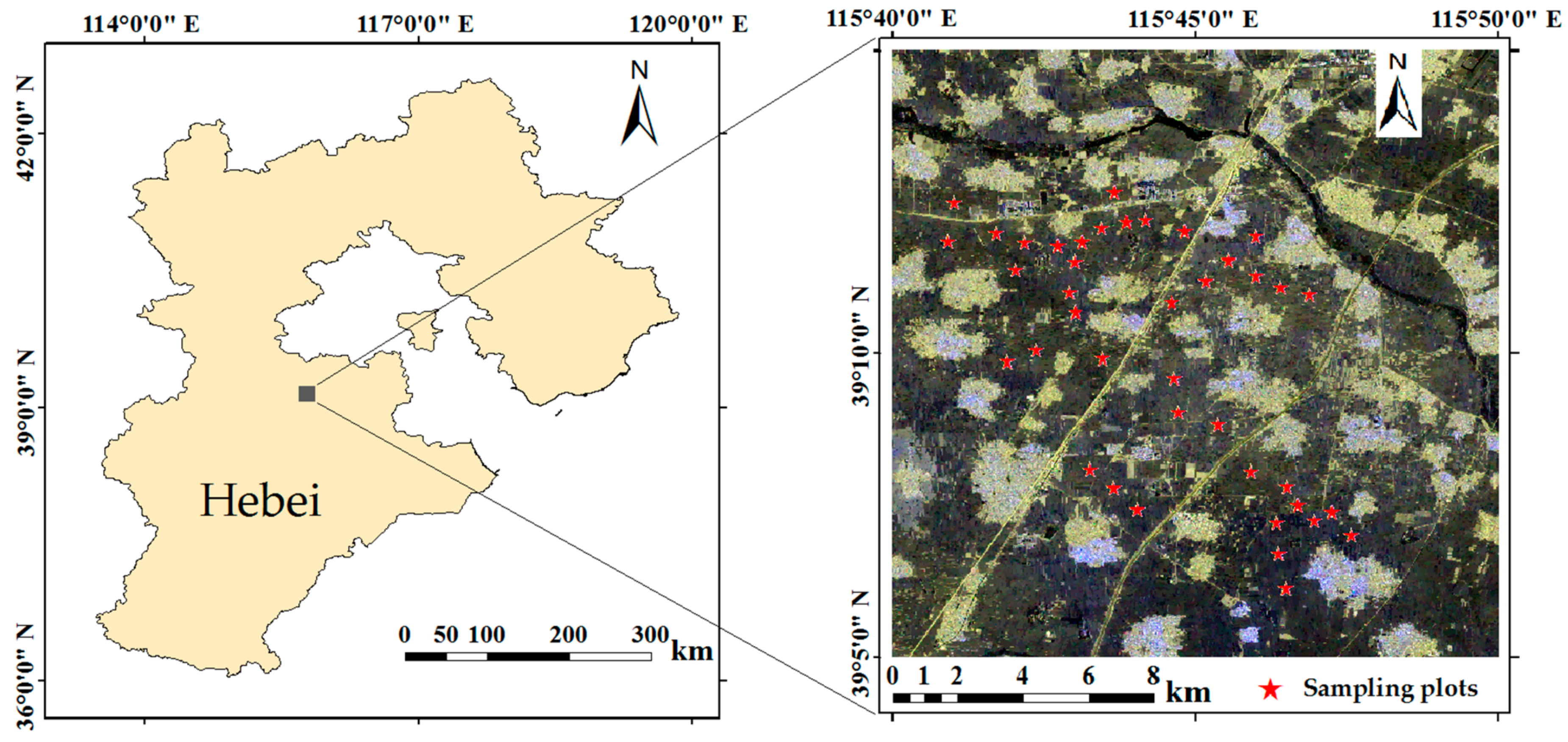
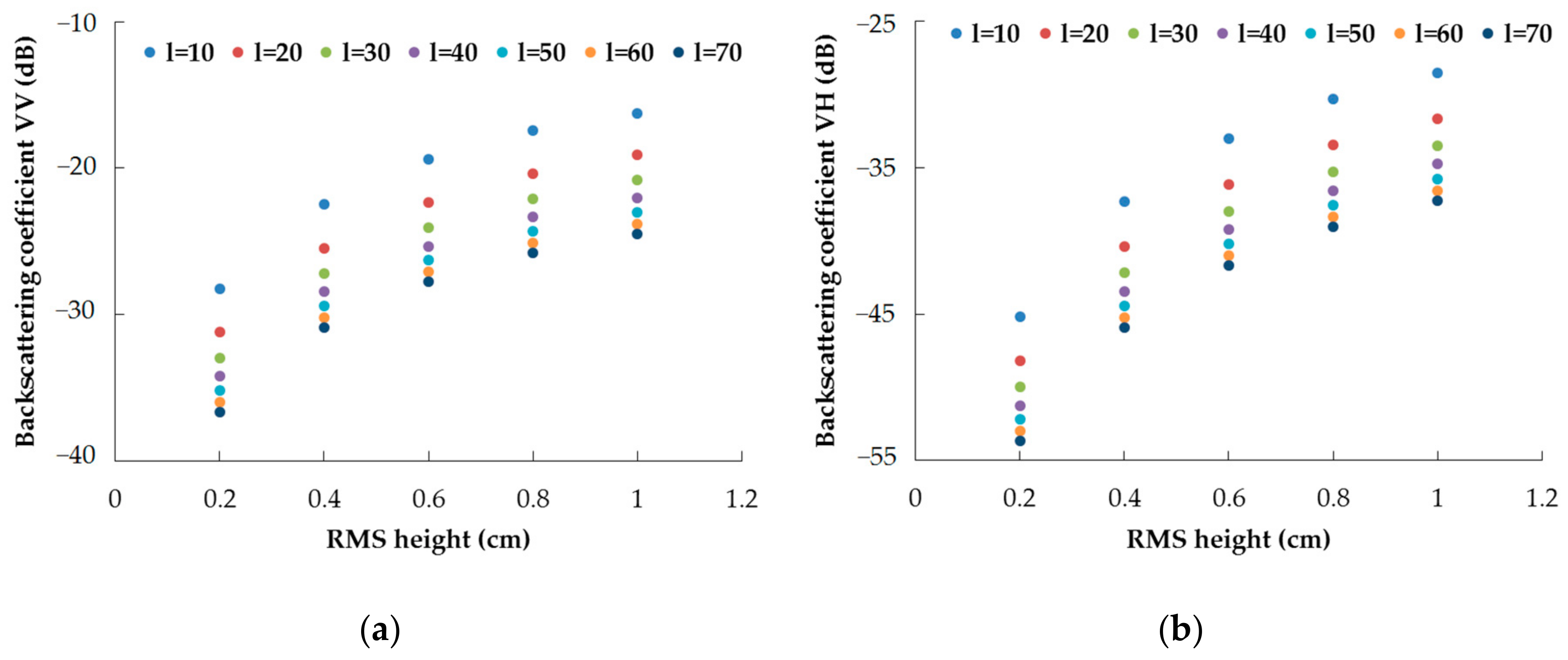
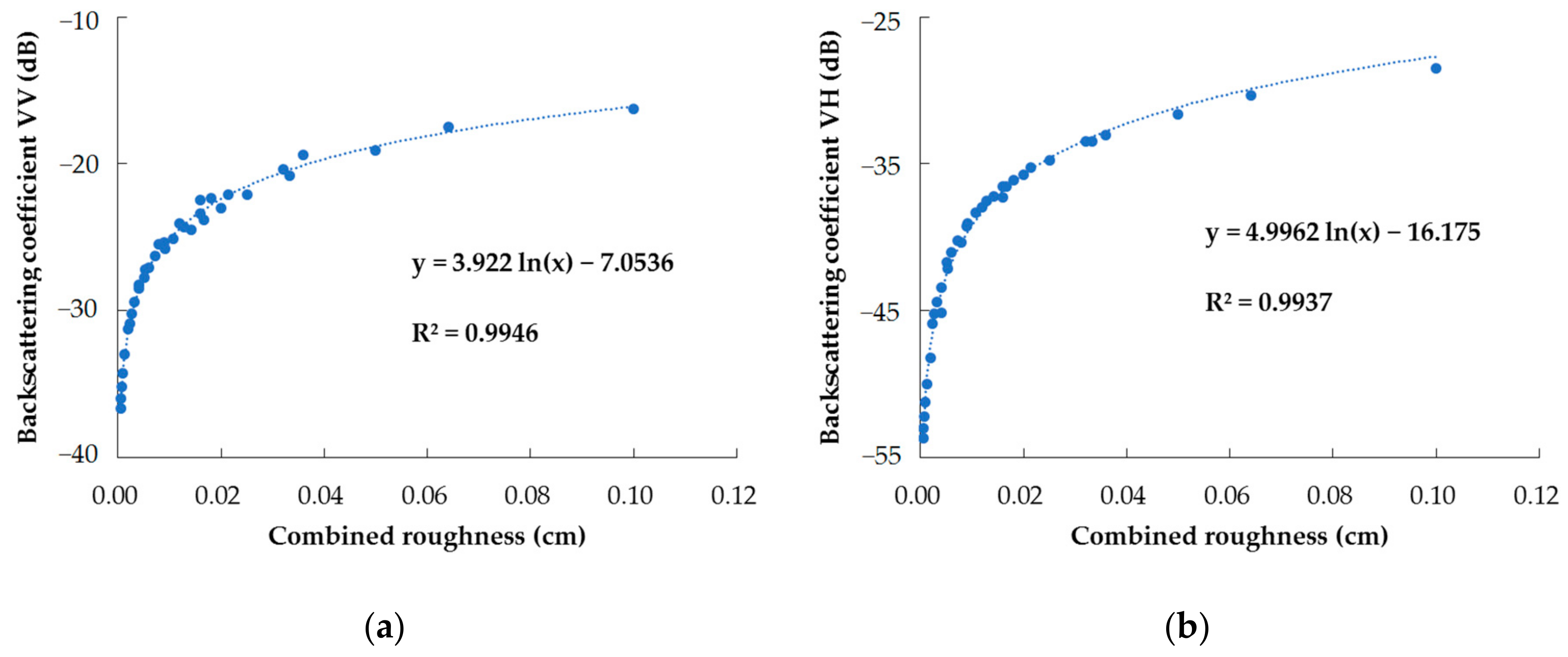
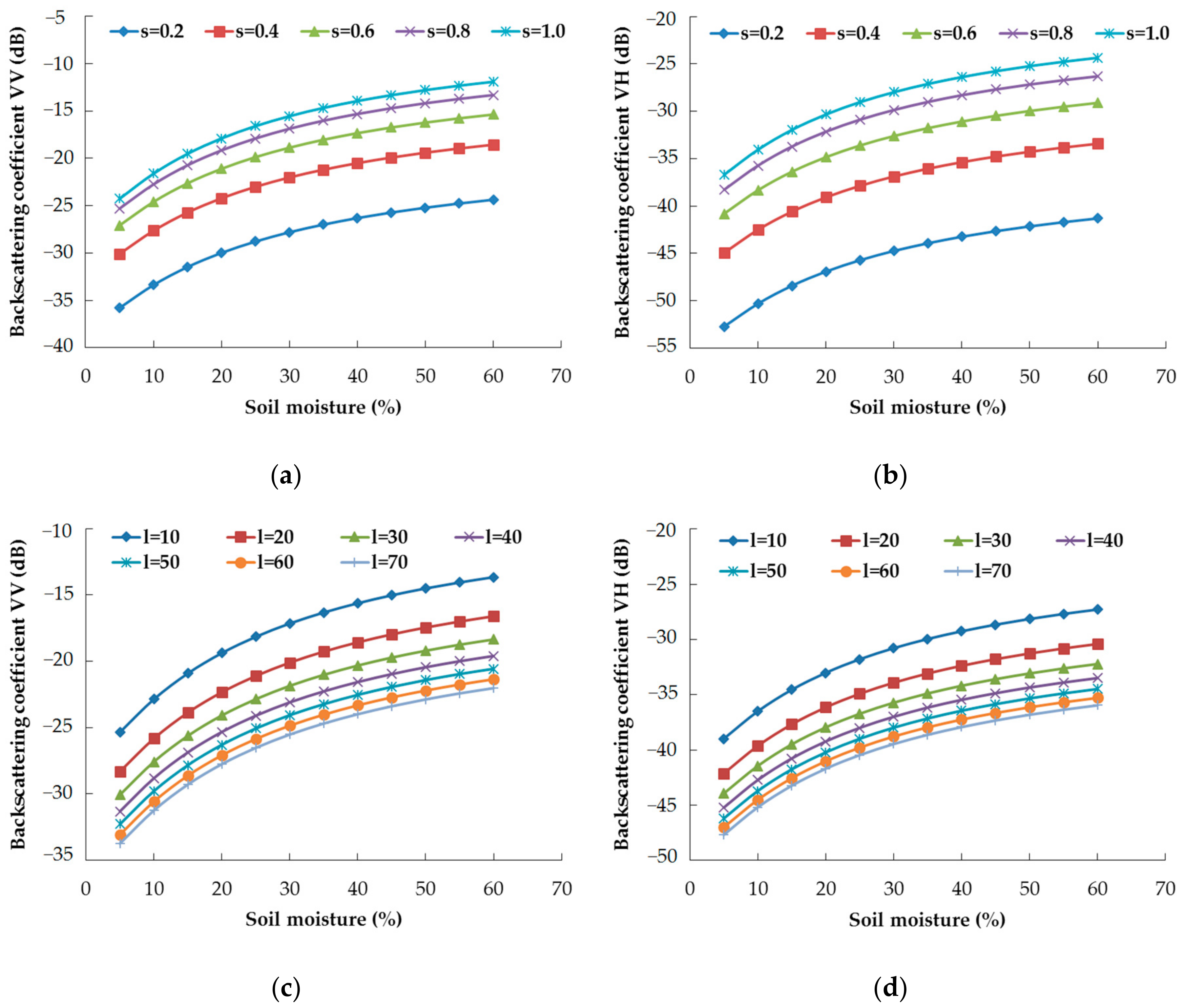
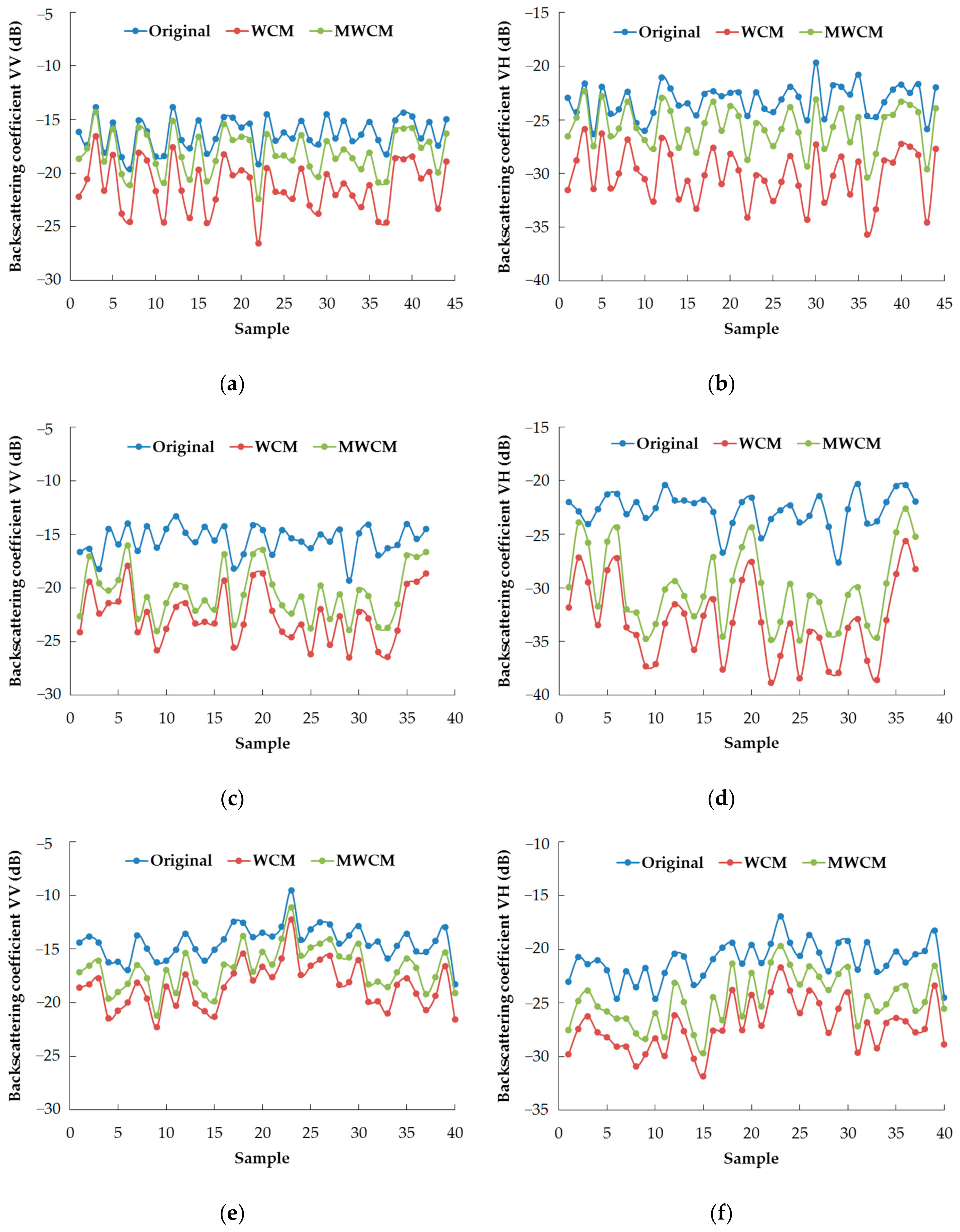

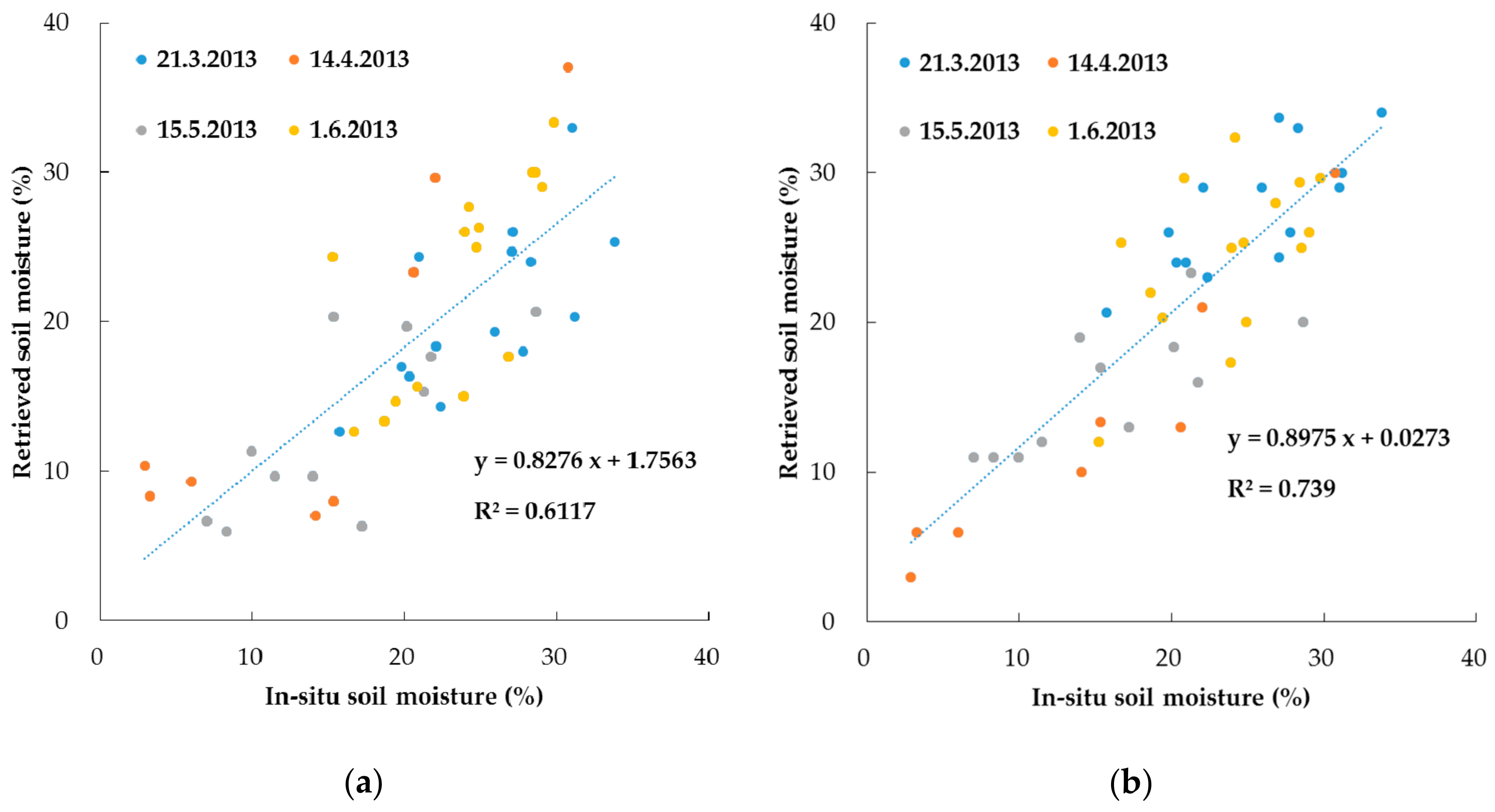
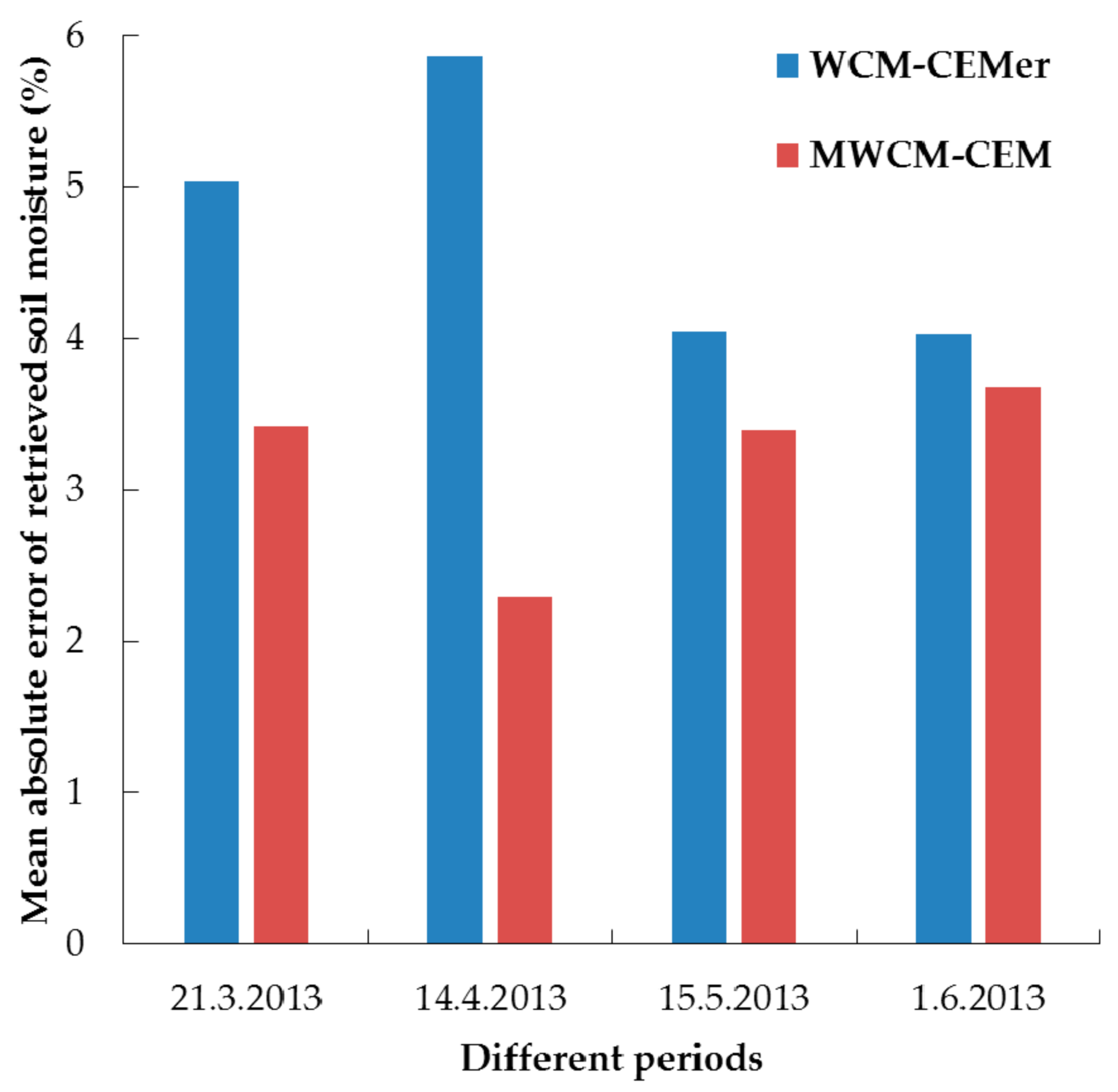
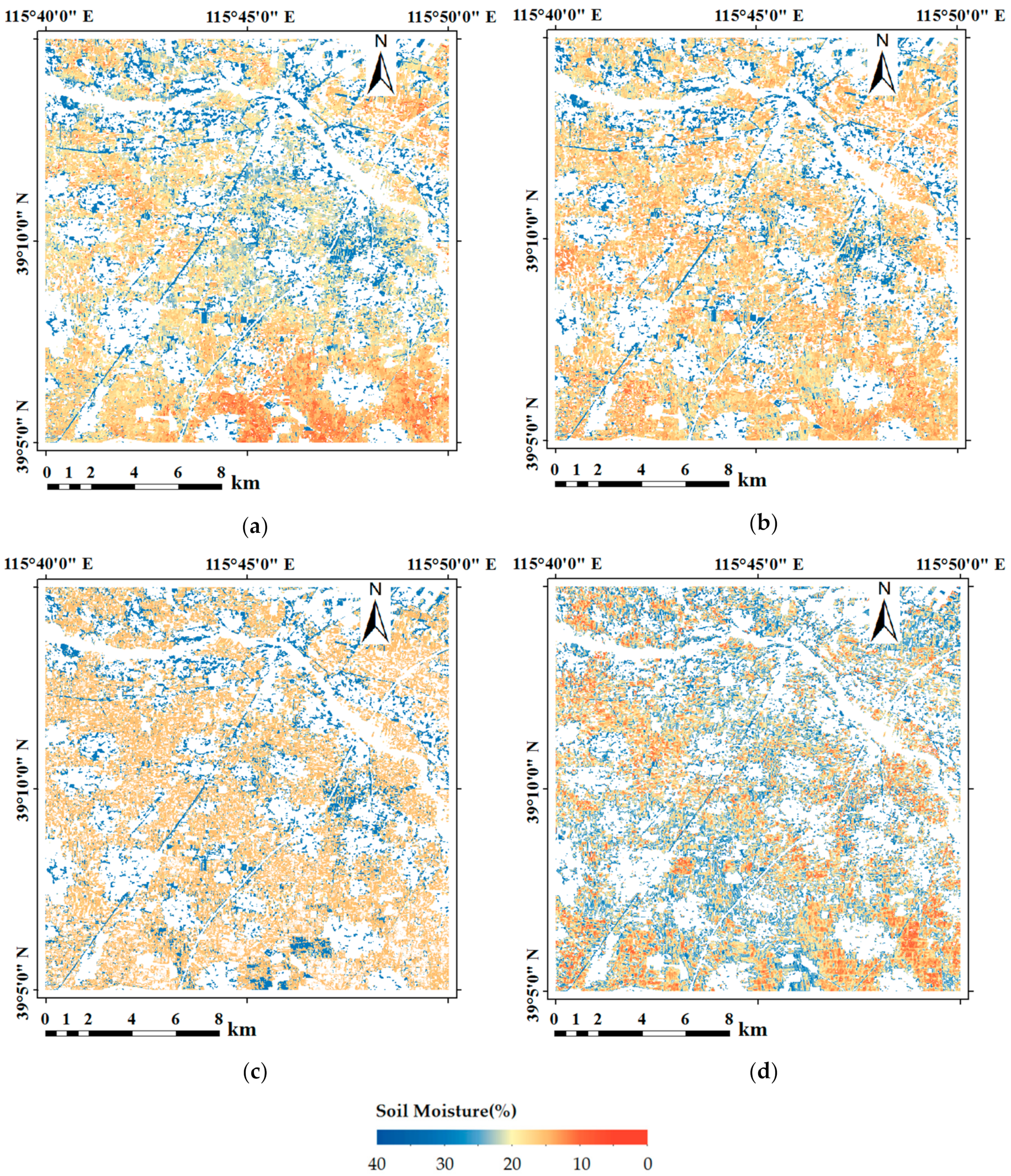
| Date | Growth Stage | Sampling Point | Soil Moisture Range (%) | RMS Height Range (cm) | Correlation Length Range (cm) |
|---|---|---|---|---|---|
| 21 March 2013 | Returning green stage | 40 | (5,49) | (0.3,0.8) | (20,60) |
| 14 April 2013 | Jointing stage | 44 | (3,41) | ||
| 15 May 2013 | Filling stage | 37 | (5,43) | ||
| 1 June 2013 | Milky maturity stage | 40 | (9,42) |
| A | B | C | D | E | F | G | H | |
|---|---|---|---|---|---|---|---|---|
| WCM-CEMmr | −2.007 | −3.268 | −0.965 | −26.650 | −4.441 | −10.090 | −2.448 | −46.880 |
| WCM-CEMer | 3.912 | 4.622 | 0.349 | −3.878 | 4.239 | 5.065 | 0.132 | −10.690 |
| MWCM-CEMmr | −1.294 | −0.393 | −0.340 | −22.350 | −3.362 | −5.861 | −1.530 | −40.430 |
| MWCM-CEM | 4.083 | 5.247 | 0.0611 | 2.090 | 4.983 | 5.123 | 0.036 | −8.005 |
Publisher’s Note: MDPI stays neutral with regard to jurisdictional claims in published maps and institutional affiliations. |
© 2021 by the authors. Licensee MDPI, Basel, Switzerland. This article is an open access article distributed under the terms and conditions of the Creative Commons Attribution (CC BY) license (http://creativecommons.org/licenses/by/4.0/).
Share and Cite
Zhang, M.; Lang, F.; Zheng, N. Soil Moisture Retrieval during the Wheat Growth Cycle Using SAR and Optical Satellite Data. Water 2021, 13, 135. https://doi.org/10.3390/w13020135
Zhang M, Lang F, Zheng N. Soil Moisture Retrieval during the Wheat Growth Cycle Using SAR and Optical Satellite Data. Water. 2021; 13(2):135. https://doi.org/10.3390/w13020135
Chicago/Turabian StyleZhang, Min, Fengkai Lang, and Nanshan Zheng. 2021. "Soil Moisture Retrieval during the Wheat Growth Cycle Using SAR and Optical Satellite Data" Water 13, no. 2: 135. https://doi.org/10.3390/w13020135
APA StyleZhang, M., Lang, F., & Zheng, N. (2021). Soil Moisture Retrieval during the Wheat Growth Cycle Using SAR and Optical Satellite Data. Water, 13(2), 135. https://doi.org/10.3390/w13020135






